Boletus L.
Recent molecular studies have shown that Boletus in its current circumscription is likely an artificial grouping and it is possible that it will be split at some point into smaller genera. Note that Boletus impolitus and Boletus depilatus for practical reasons are retained here, although there is strong evidence that they are closely related to Xerocomus subtomentosus and its allies.
Fruitbody large to medium sized, boletoid, without veil and ring. Stipe solid, with surface usually covered with granules or network. Flesh variously coloured, changing or not when exposed to air. Tubes easily separable from each other, not tearing apart. Pores usually small and rounded.
Boletus queletii Schulzer
Description
Pileus up to 9 cm, convex to flat-convex, velvety to smooth, bright yellow, olivaceous yellow, yellowish orange, orange, orange red to red or vinaceous red, in places discolouring, blueing when bruised. Stipe cylindrical or club-shaped, sometimes rooting, pale yellow to yellow, covered with fine pale orange, orange, reddish orange or pale red granules, in the base vinaceous red; stipe surface blueing when bruised. Flesh pale yellow to lemon yellow, vinaceous red to vinaceous brown in the stipe base, bleuing when exposed to air. Tubes pale yellow to yellow with olivaceous tint, blueing when injured. Pores red to orange red or orange, blueing when bruised. Smell not distinctive. Taste not distinctive. Spores 9–14 × 4.5–7 μm, ratio 1.5–2.6. Pileipellis (the cap cuticle) a trichoderm, composed of hyphae of cylindrical cells. Chemical reactions: hyphae of the flesh in the stipe base amyloid in Melzer’s reagent.
Habitat. Warm broadleaf forests, mycorrhizal with oaks (Quercus), rarely also with hornbeam (Carpinus), hazel (Coryllus), beech (Fagus) or birch (Betula).
Distribution. In Europe widespread but apparently more common in south.
Similarity. Slightly similar to Boletus luridiformis, but distinguished by the presence of vinaceous red flesh in the stipe base, as well by its shorter spores with different length/width ratio. Rarely Boletus queletii may show blurred network-like pattern on the stipe and then it resembles Boletus luridus. In those cases Boletus queletii is recognized by the yellow flesh (not orange or red) when the tubes are removed.
Photographs
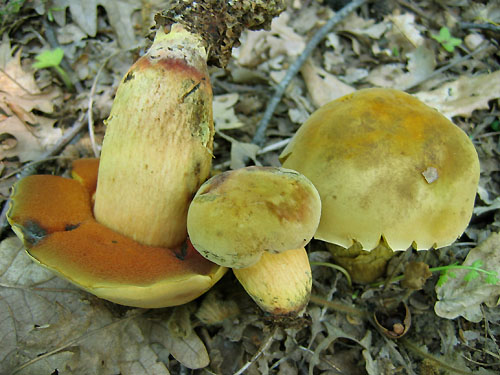
Fruitbodies of Boletus queletii. Note the colour variability. (photo B. Assyov)
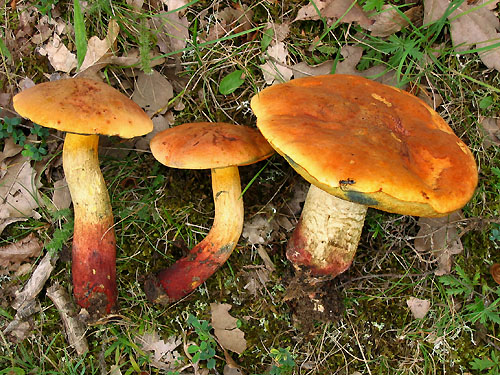
Fruitbodies of Boletus queletii. Note the colour variability and the red stipe base. (photo B. Assyov)
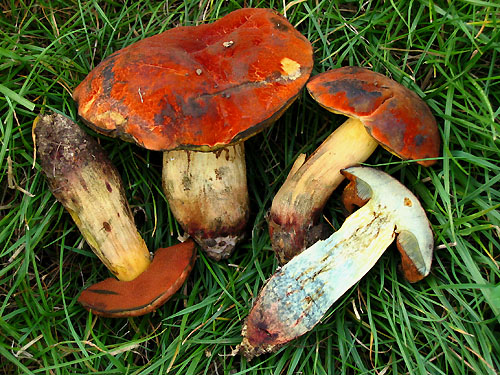
Fruitbodies of Boletus queletii. Note the colour variability, the red stipe base and the vinaceous flesh in the stipe base. (photo B. Assyov)
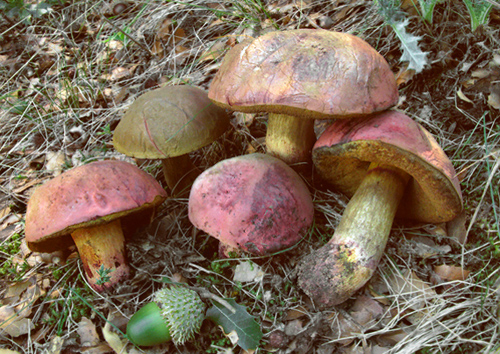
Discoloured fruitbodies of Boletus queletii as often seen in arid environment. (photo I. Assyova)

Fruitbodies of Boletus queletii. Note the colour variability and the vinaceous flesh in the stipe base. (photo B. Assyov)
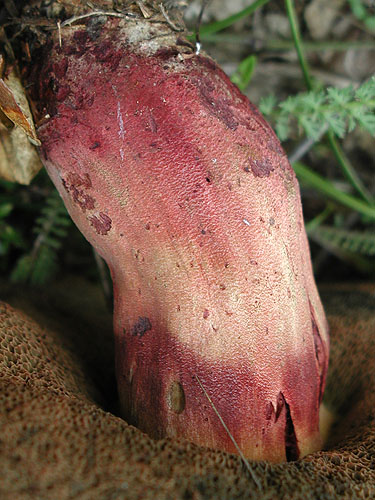
Boletus queletii - stipe surface. (photo B. Assyov)

Boletus queletii - spores. Sclae bar = 10 μm. (photo B. Assyov)
Important literature
Alessio, C.L. 1985. Boletus Dill. ex L. (sensu lato). – In: Fungi Europaei. Vol. 2. Pp. 1–705. Libreria editrice Biella Giovanna, Saronno.
Breitenbach J. & Kränzlin F. 1991. Pilze der Schweiz. Bd. 3(1). Röhrlinge und Blätterpilze. Verlag Mykologia, Luzern.
Engel, H., Krieglsteiner, G., Dermek, A. & Watling, R. 1983. Dickröhrlinge. Die Gattung Boletus in Europa. Verlag Heinz Engel, Weidhausen b. Coburg.
Estadès, A. & Lannoy, G. 2004. Les bolets européens. – Bulletin Mycologique et Botanique Dauphiné-Savoie 44(3): 3–79.
Galli, R. 1998. I Boleti. Atlante pratico-monographico per la determinazione dei boleti. Edinatura, Milano.
Hansen, L. & Knudsen, H. 1992. Nordic Macromycetes. Vol. 2. Polyporales, Boletales, Agaricales, Russulales. Nordsvamp, Copenhagen.
Knudsen, H. & Vesterholt, J. [eds.]. 2008. Funga Nordica. Nordsvamp, Kopenhagen.
Lannoy, G. & Estadès, A. 2001. Les Bolets. Flore mycologique d’Europe. Documents Mycologiques Mémoire Hors série no. 6. Pp. 1–163. Association d’Écologie et de Mycologie, Lille.
Muñoz, J.A. 2005. Boletus s. l. – In: Fungi Europaei. Vol. 1. Pp. 1–951. Edizioni Candusso, Alassio.
Pilát, A. & Dermek, A. 1974. Hríbovité huby. Československé hríbovité a sliziakovité huby (Boletaceae – Gomphidiaceae). Veda, Bratislava.
Singer, R. 1967. Die Röhrlinge. II. Die Boletoideae und Strobilomycetaceae. – In: Die Pilze Mitteleuropas. Vol. 6. Pp. 1–151. Julius Klinkhardt Verlag, Bad Heilbrunn.
Šutara, J., Mikšík, M. & Janda, V. 2009. Hřibovité houby. Čeled’ Boletaceae a rody Gyrodon, Gyroporus, Boletinus a Suillus. Academia, Praha.
Watling, R. 1970. Boletaceae, Gomphidiaceae, Paxillaceae. – In: Henderson, D.M., Orton, P.D. & Watling, R. [eds]. British fungus flora. Agarics and Boleti. Vol. 1. Royal Botanic Garden, Edinburgh.
Watling, R. & Hills, A.E. 2005. Boletes and their allies (revised and enlarged edition). – In: Henderson, D.M., Orton, P.D. & Watling, R. [eds]. British Fungus Flora. Agarics and boleti. Vol. 1. Royal Botanic Garden, Edinburgh.